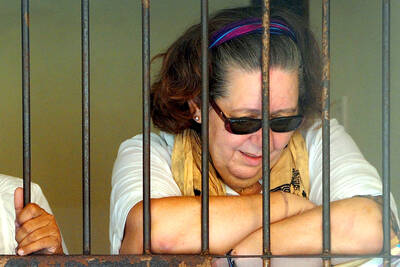Egypt and Germany have been fighting for possession of her for 90 years but, because Adolf Hitler loved her, she remained in Berlin's Egyptian art museum.
In a dispute as old as the land of the Nile itself, Egypt has repeatedly reasserted its claim to the wayward beauty it says is being held illegally in Berlin.
The wayward beauty is one of the great masterpieces of Ancient Egyptian art -- the 3,300-year-old bust of 18th Dynasty Queen Nefertiti. Now she is on the move again. She will not be going home to Egypt. Instead, she will be moving across town to new digs, relinquishing her pedestal in a converted guard house in what used to be West Berlin for more royal surroundings in the heart of reunited Berlin.
The wounds of post-war division are finally healing over, and the German capital's Egyptian art collection, one of the finest outside Egypt itself, is being brought back together at long last.
The painted limestone and plaster bust, depicting the elegantly chiselled life-sized features of a stunningly beautiful woman wearing a unique cone-shaped headdress, has formed the cornerstone of Berlin's Egyptian collection since German archeologists discovered the bust in the ruins of an ancient artist's studio on the banks of the Nile in 1912.
The collection initially was housed at the Neues Museum (New Museum) just a few meters from the Hohenzollern Palace in the heart of Berlin. Reflecting the fashion of the times, the museum itself was done up inside to resemble an Ancient Egyptian temple, complete with hieroglyphic inscriptions on the walls.
But as bombs rained down on Berlin during World War II, curators hastily stashed the city's art treasures at warehouses outside the city. After the war, some of those warehouses turned out to be in East Germany, and others in West Germany.
Nefertiti ended up in the west and took up residency in West Berlin's makeshift Egyptian museum in a converted guard house across the street from Charlottenburg Palace. But the bulk of the Berlin Egyptian collection remained in the east, and was on view at the Bode Museum in East Berlin until the Berlin Wall came down.
Since then, the city has been working to renovate and, in some cases, rebuild the 19th Century museum complex that once graced the center of this city.
Around the middle of the year, work will have progressed enough that the Egyptian collection will be able to be reunited under one roof for the first time since the war.
Nefertiti will be removed from the converted guard house on March 2 to take up temporary residence at the Kultur Forum exhibition hall at Potsdamer Platz in the revivified centre of Berlin. There, she will form the focal point of a six-month exhibit on Egyptian hieroglyphs and their influence on art up to the modern day.
If all goes according to plan, Nefertiti will be able to move into the newly rebuilt but anachronistically named Altes Museum (Old Museum).
But even the Altes Museum is only temporary lodgings for her. Her original digs in the nearby Neues Museum will be ready by 2008 or 2009, thus bringing her back home again.
An alluring mystery has surrounded the bust since its discovery on Dec. 7, 1912, incredibly intact and sporting vibrant colors, after lying in forgotten in the sands since the tumultuous days at the close of the reign of Pharaoh Akhenaton, one of the most enigmatic rulers of all time.
In 1913, the Ottoman Empire agreed to allow its finder, part-time German-Jewish archeologist and full-time entrepreneur James Simon, to retain possession of the bust.
Simon carted it off to Europe and displayed Nefertiti prominently displayed in his home in Berlin before later lending it to the Berlin museum and finally donating it in 1920 to the Berlin collection.
In 1933 the Egyptian government demanded Nefertiti's return -- the first of many such demands over the decades to come. One of the many titles Hermann Goering held was premier of Prussia (which included Berlin) and, acting in that capacity, Goering suggested to King Fouad I of Egypt that Nefertiti would soon be back in Cairo.
But Hitler had other plans. Through the ambassador to Egypt, Eberhard von Stohrer, Hitler informed the Egyptian government that he was an ardent fan of Nefertiti: "I know this famous bust," the fuehrer wrote. "I have viewed it and marvelled at it many times. Nefertiti continually delights me. The bust is a unique masterpiece, an ornament, a true treasure!"
Hitler said Nefertiti had a place in his dreams of rebuilding Berlin and renaming it Germania.
"Do you know what I'm going to do one day? I'm going to build a new Egyptian museum in Berlin," Hitler went on. "I dream of it. Inside I will build a chamber, crowned by a large dome. In the middle, this wonder, Nefertiti, will be enthroned. I will never relinquish the head of the Queen."
Hitler and his mad dreams are long dead. But Nefertiti continues to smile serenely. As she has for 3,300 years. As if to say, this too shall pass. And I shall endure.

Indonesia was to sign an agreement to repatriate two British nationals, including a grandmother languishing on death row for drug-related crimes, an Indonesian government source said yesterday. “The practical arrangement will be signed today. The transfer will be done immediately after the technical side of the transfer is agreed,” the source said, identifying Lindsay Sandiford and 35-year-old Shahab Shahabadi as the people being transferred. Sandiford, a grandmother, was sentenced to death on the island of Bali in 2013 after she was convicted of trafficking drugs. Customs officers found cocaine worth an estimated US$2.14 million hidden in a false bottom in Sandiford’s suitcase when

CAUSE UNKNOWN: Weather and runway conditions were suitable for flight operations at the time of the accident, and no distress signal was sent, authorities said A cargo aircraft skidded off the runway into the sea at Hong Kong International Airport early yesterday, killing two ground crew in a patrol car, in one of the worst accidents in the airport’s 27-year history. The incident occurred at about 3:50am, when the plane is suspected to have lost control upon landing, veering off the runway and crashing through a fence, the Airport Authority Hong Kong said. The jet hit a security patrol car on the perimeter road outside the runway zone, which then fell into the water, it said in a statement. The four crew members on the plane, which

POWER ABUSE WORRY: Some people warned that the broad language of the treaty could lead to overreach by authorities and enable the repression of government critics Countries signed their first UN treaty targeting cybercrime in Hanoi yesterday, despite opposition from an unlikely band of tech companies and rights groups warning of expanded state surveillance. The new global legal framework aims to bolster international cooperation to fight digital crimes, from child pornography to transnational cyberscams and money laundering. More than 60 countries signed the declaration, which means it would go into force once ratified by those states. UN Secretary-General Antonio Guterres described the signing as an “important milestone,” and that it was “only the beginning.” “Every day, sophisticated scams destroy families, steal migrants and drain billions of dollars from our economy...

Japan’s ruling Liberal Democratic Party (LDP) and its junior partner yesterday signed a coalition deal, paving the way for Sanae Takaichi to become the nation’s first female prime minister. The 11th-hour agreement with the Japan Innovation Party (JIP) came just a day before the lower house was due to vote on Takaichi’s appointment as the fifth prime minister in as many years. If she wins, she will take office the same day. “I’m very much looking forward to working with you on efforts to make Japan’s economy stronger, and to reshape Japan as a country that can be responsible for future generations,”